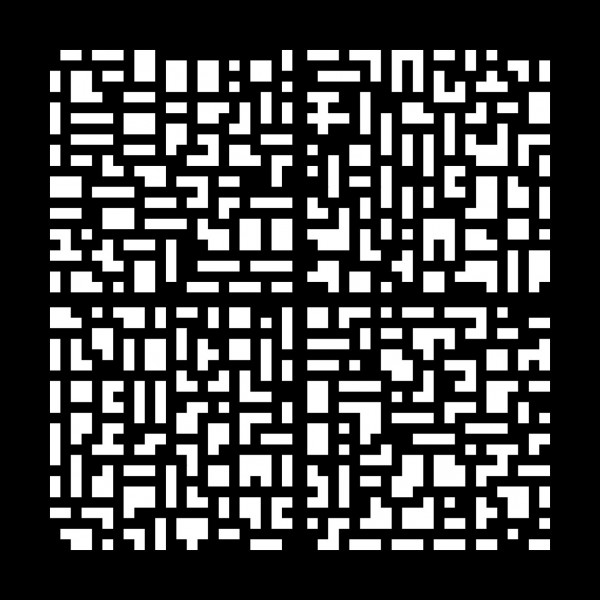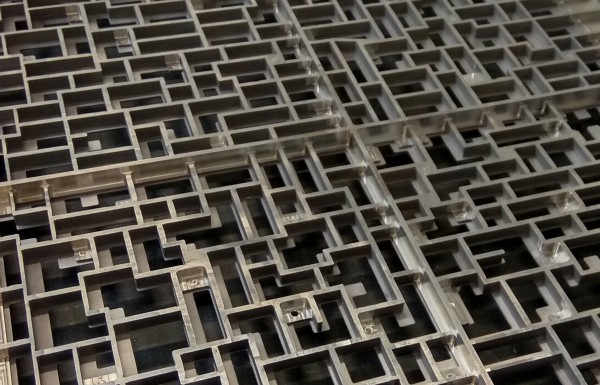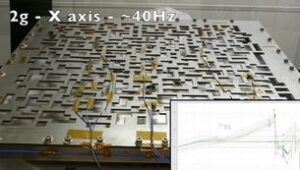For a mission such as SVOM, large field-of-view instruments are needed to maximise the chances of discovery. The ECLAIRs telescope is a matter of balance: it must detect bursts with the maximum sensitivity, i.e. have a large sensitive area, while determining their location with the best precision in a very wide field of view. The satellite can then change its orientation to align the small field telescopes in the direction of the burst. Unfortunately, it is impossible to apply the principles of optical focusing to the observation of hard X-rays and gamma rays over large fields of view. The solution is to use a completely different technique: the coded mask technique.
Coding the sky light
This technology is based on the idea of coding the signal from each point of the sky with a particular pattern. When light passes through the mask, which is made up of holes and filled areas, each source in the sky projects a unique pattern onto the detection plane. On this plane, the sum of all the sky points that have passed through the mask is found. Using a mathematical tool (deconvolution), the signal from each sky point is then reconstructed.

In the case of a strong source, it is possible to determine the characteristic pattern with the eye (see Figure 1). For a weaker source, mathematics helps to find the source. If, however, the photon flux is insufficient, reconstruction is impossible because the source signal cannot be distinguished from the noise signal. The sensitivity limit is then reached.
An amazing effect of the code mask is its ability to separate multiple sources. On the detection plane, all sources are mixed together. The deconvolution tool is able to determine the origin of the photons involved. For example, it is possible to determine whether one third of the photons come from a gamma-ray burst, one third from background noise and one third from a known high-energy X-ray source in the field of view (e.g. the Crab pulsar). The sky is thus reconstructed.
In order to project the shadow of the mask onto the detection plane, the mask must of course be able to block the considered radiation. To block visible light, a simple sheet of paper is sufficient. In the case of the X-rays that ECLAIRs wishes to record (hard X-ray domain), very dense materials are required (if we want to keep a thin mask, which is a necessary constraint in our case). Tantalum with 2.5% tungsten was chosen. The density of tantalum is 16.4 g.cm-3. One litre of tantalum weighs more than 16 kg (for comparison, the same volume of lead weighs less than 12 kg, and of course only 1 kg for water).
Encoding key
To assign a pattern to a point of the sky, digging holes in a plate is not enough. First, you need to know what you have modulated the signal with in order to use the deconvolution tool. This principle is based on multiplexing, which consists of mixing several signals according to a defined code and then transmitting all the information in a single data packet. On reception, a demultiplexer performs the opposite operation, breaking down the signals according to the code and restoring the information carried by each signal. This process is common and is used, for example, in the telecommunications field.
The coded mask technique follows the same reasoning. The signal of the target source is mixed with all the contributions external to the source (other sources present in the field of view of the instrument, diffuse component, instrumental noise). The data packet which has been passed through the coded mask filter is then used by a specific deconvolution algorithm to reconstruct the characteristics of the source, such as its position, its intensity or its energy spectrum.
The choice of the mask pattern
The mask pattern is based on the levels of accuracy and sensitivity that are to be achieved. Once the characteristics of the instrument have been defined, such as the size of the mask, the size of the detection plane or the distance between them, the mask pattern must be refined according to scientific needs. Precise localization implies small holes, while conversely, large holes will increase the sensitivity, i.e. the chance of detecting something in the sky. Both aspects are essential and the choice is a difficult one. The burst position computed by ECLAIRs will be used by the spacecraft to place the burst within the field of view of the MXT and VT telescopes. The mask design shall also ensure that the burst detection efficiency is optimal to fulfill the mission science goals.
In addition to these scientific performances, there are mechanical constraints. The SVOM mask is the first to be self-supporting (i.e. we cannot use a rigid structure on which to place the mask elements, but our mask must actually be manufactured by drilling holes in a metal). During the launch of the satellite, the rocket causes very high mechanical vibrations, which result in extreme stresses on the mask. To be able to withstand the vibrations, the mask pattern must include a cross, which had to be integrated into the scientific pattern.
A specific algorithm is used to generate large patterns from which the four quadrants of the final mask can be selected (Figure 2). After hundreds of thousands of computer-generated masks, a compromise that guarantees a sufficiently precise localisation has been found. Once this balance has been reached, the final pattern is chosen from the most sensitive mask. The scientific pattern finally obtained is called “C3A2S” (Figure 3).


Vignetting
Unfortunately, the coded mask is not limited to the scientific pattern drilled into our tantalum sheet. This sheet, which allows 40% of the light to pass through, would have no chance of surviving the vibrations during take-off. It must therefore be strengthened. The only way to strengthen it is to add material, but the thicker the mask, the smaller the field of view. Photons are stopped by vignetting (see Figure 4). This is why the thickness of the tantalum foil is limited to 0.6mm.

In order to achieve the required specifications, the plate would therefore have to be no thicker than 0.6 mm. But at this size, a single sheet of tantalum, a metal chosen for its X-ray absorption capacity, is likely to break during take-off.
How can we make the mask more robust without adding material? Simply by ensuring that the light coming from our field of view continues to see the holes in the same way. By cleverly calculating the setbacks from the edges of the tantalum holes, we were able to add 10mm thick ridges and a 16mm central cross.
The tantalum is thus sandwiched between two titanium masks (referred to as TiTaTi mask). The top mask (TiTop) has 10mm ridges in addition to the 16mm cross, while the bottom mask (TiBottom) is only 1mm thick with a 16mm cross. To ensure rigidity, titanium pins are welded to connect the TiTop and TiBottom masks. Finally, Tantalum pads are glued to the pins to ensure X-ray opacity.


Contacts: Coded mask scientist: Cyril Lachaud (APC). Coded mask project manager: Alain Givaudan (APC).
Credits: the coded mask is the result of the work of a large and multidisciplinary team based at APC, CEA and CNES. Special thanks to Aleksandra Gros and Stéphane Schanne (who give an A and an S to the name of the mask). APC laboratory coded mask team: Walter Bertoli, Stéphane Dheilly, Alain Givaudan, Corinne Juffroy, Maurice Karakac, Cyril Lachaud.




